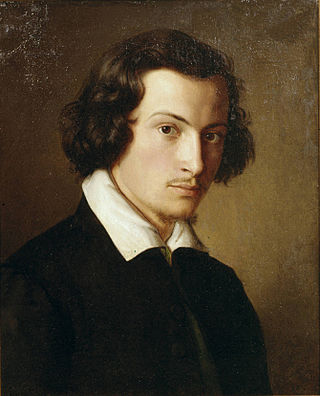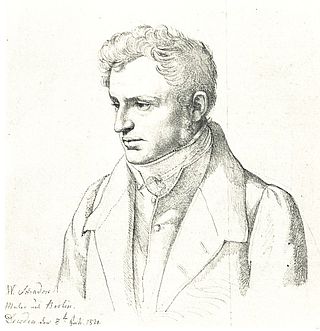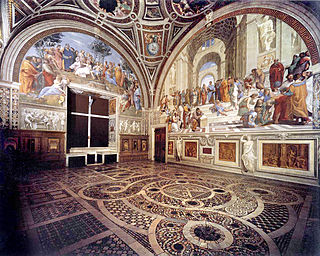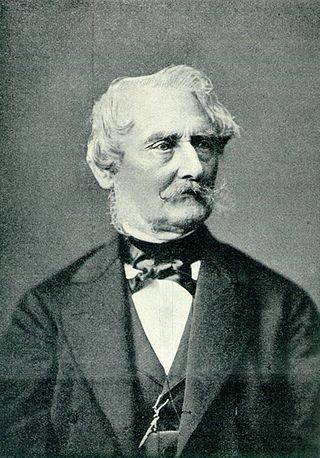This article needs additional citations for verification .(August 2014) |


Julius Schoppe (27 January 1795, Berlin - 30 March 1868, Berlin) was a German portrait, landscape, history and fresco painter in the Biedermeier style.
This article needs additional citations for verification .(August 2014) |


Julius Schoppe (27 January 1795, Berlin - 30 March 1868, Berlin) was a German portrait, landscape, history and fresco painter in the Biedermeier style.
He came from a family of goldsmiths and was related to the sculptor Johann Gottfried Schadow. From 1810 to 1817, he was enrolled at the Prussian Academy of Arts, [1] where he studied under Samuel Rösel . A stay in Vienna from 1815 to 1816 was followed the next year by a hike through Austria and Switzerland that ended in Rome. The sketches he made during this trip were published as a series of lithographs from 1823 to 1825. He lived in Rome until 1822 (with a fellowship from the Academy) at the Casa Buti, which was also the home of Bertel Thorvaldsen and Wilhelm von Humboldt, among others. While there, he made copies of many Renaissance paintings by Raphael, Titian and Correggio. Seven of his copies found their way into the Raphael Collection of King Friedrich Wilhelm IV in the Orangerie at Sanssouci.
Upon his return to Berlin, he was named a member of the Academy and was appointed a Professor in 1836. [1] He specialized in portraits and was especially esteemed for his portrayals of children. He also did decorative painting, from designs by Karl Friedrich Schinkel, including the tea room of Princess Elisabeth in the Berliner Stadtschloss and the entryway of the "New Pavilion" near the Schloss Charlottenburg, both of which were later destroyed.
Among those that survive are paintings in the palace of Prince Charles near the Wilhelmplatz, the tea room of the "Kleinen Neugierde", a cottage in the pleasure ground of the Glienicke Palace, and frescoes on the ceiling at the Berlin State Opera.

Raffaello Sanzio da Urbino, now generally known in English as Raphael, was an Italian painter and architect of the High Renaissance. His work is admired for its clarity of form, ease of composition, and visual achievement of the Neoplatonic ideal of human grandeur. Together with Leonardo da Vinci and Michelangelo, he forms the traditional trinity of great masters of that period.

Philipp Veit was a German Romantic painter and one of the main exponents of the Nazarene movement. It is to Veit that the credit of having been the first to revive the nearly forgotten technique of fresco painting is due.

Wilhelm von Kaulbach was a German painter, noted mainly as a muralist, but also as a book illustrator. His murals decorate buildings in Munich. He is associated with the Düsseldorf school of painting.

Julius Schnorr von Carolsfeld was a German painter, chiefly of Biblical subjects. As a young man he associated with the painters of the Nazarene movement who revived the florid Renaissance style in religious art. He is remembered for his extensive Picture Bible, and his designs for stained glass windows in cathedrals.

Friedrich Wilhelm von Schadow was a German Romantic painter.

The epithet Nazarene was adopted by a group of early 19th-century German Romantic painters who aimed to revive spirituality in art. The name Nazarene came from a term of derision used against them for their affectation of a biblical manner of clothing and hair style.

Johann Friedrich Overbeck was a German painter and a founder of the Nazarene art movement.

The Palazzo Pitti, in English sometimes called the Pitti Palace, is a vast, mainly Renaissance, palace in Florence, Italy. It is situated on the south side of the River Arno, a short distance from the Ponte Vecchio. The core of the present palazzo dates from 1458 and was originally the town residence of Luca Pitti, an ambitious Florentine banker.

Sebastiano del Piombo was an Italian painter of the High Renaissance and early Mannerist periods famous as the only major artist of the period to combine the colouring of the Venetian school in which he was trained with the monumental forms of the Roman school. He belongs both to the painting school of his native city, Venice, where he made significant contributions before he left for Rome in 1511, and that of Rome, where he stayed for the rest of his life, and whose style he thoroughly adopted.

The four Raphael Rooms form a suite of reception rooms in the Apostolic Palace, now part of the Vatican Museums, in Vatican City. They are famous for their frescoes, painted by Raphael and his workshop. Together with Michelangelo's Sistine Chapel ceiling frescoes, they are the grand fresco sequences that mark the High Renaissance in Rome.

Jørgen Roed,, Danish portrait and genre painter associated with the Golden Age of Danish Painting, was born in Ringsted to Peder Jørgensen Roed and wife, Ellen Hansdatter.

Asmus Jacob Carstens was a Danish-German painter, one of the most committed artists of German Neoclassicism. His career was erratic, partly because of his difficult personality, and the majority of his large projects were left incomplete, or subsequently destroyed. Much of what survives is in the form of drawings, many using "a schematic, pale colouring as a timid and humble accessory to the dominating figure-drawing", that were planned for large fresco commissions that never materialized.

Schloss Charlottenburg is a Baroque palace in Berlin, located in Charlottenburg, a district of the Charlottenburg-Wilmersdorf borough, among the largest palaces in the world.

Eduard Julius Friedrich Bendemann was a German-Jewish painter.
August Wilhelm Julius Ahlborn was a German landscape painter.

Johann Heinrich Strack was a German architect of the Schinkelschule. His notable works include the Berlin Victory Column.

Portrait of Pope Julius II is an oil painting of 1511–1512 by the Italian High Renaissance painter Raphael. The portrait of Pope Julius II was unusual for its time and would carry a long influence on papal portraiture. From early in its life, it was specially hung at the pillars of the church of Santa Maria del Popolo, on the main route from the north into Rome, on feast and high holy days. Giorgio Vasari, writing long after Julius' death, said that "it was so lifelike and true it frightened everyone who saw it, as if it were the living man himself".

Johann Philipp Eduard Gaertner was a German painter who specialized in depictions of urban architecture.

Friedrich Wilhelm Ternite was a German portrait painter, miniaturist and lithographer. In Berlin, he served as a court painter and inspector of the Royal Art Gallery.

Friedrich Geselschap was a German history painter, in the Classical style.
![]() Media related to Julius Schoppe at Wikimedia Commons
Media related to Julius Schoppe at Wikimedia Commons